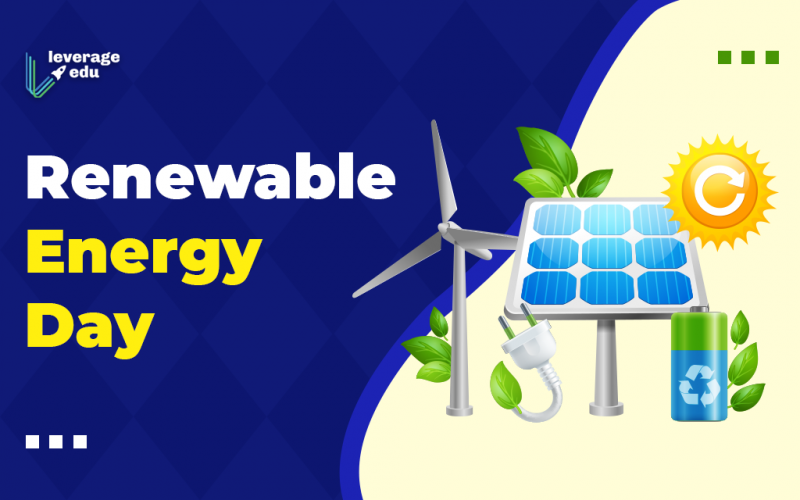Renewable Energy Day, also called the Indian Akshay Urja Diwas, is celebrated on August 20 annually. This special day commemorates the birth anniversary of Rajiv Gandhi, the former Prime Minister of India. The Ministry of New and Renewable Energy (MNRE), Govt. of India, initiated National Renewable Energy Day in 2004. This day is celebrated to raise awareness about the importance of renewable energy and popularise the need, benefits and uses of renewable energy devices and systems in all spheres of life. On Renewable Energy Day, the state departments organise various quizzes and competitions to instil environmental consciousness among the school and college students. This blog brings you all the information about Indian Akshay Urja Diwas or Renewable Energy Day!
Let’s Understand the Importance of Energy Conservation!
Table of contents
History of Indian Akshay Urja Day

The main objective of Indian Akshay Urja Day or Renewable Energy Day is to promote renewable energy development programs and encourage its use as an alternative to traditional energy sources. Former Prime Minister Dr Manmohan Singh organised the first event linked to Akshay Urja Diwas in New Delhi. In 2004, the Prime Minister published a memorial stamp, and 12,000 school children formed a human chain. The target group of this programme are school and college students. Different competitions are organised like school level Quiz, Sit & Draw, debate competitions and cultural programmes on Renewable Energy Day. Schools also conduct rallies with Posters, Banners and Slogans. In 2012, another rally of Battery Operated Two Wheelers was introduced along with the traditional rally.
Must Read: MBA in Energy Management
What is Renewable Energy?
To celebrate Indian Akshay Urja Day, you must familiarize yourself with the meaning of renewable energy. Energy such as solar energy, wind energy, hydro-electrical power, biomass and geothermal energy are a few examples of renewable energy. They are derived from renewable resources that are naturally replenished on a human timescale. Renewable energy sources include carbon-neutral sources like sunlight, wind, rain, tides, waves, and geothermal heat. They are better than traditional energy sources like fossil fuels that are exhaustible and take millions of years to replenish.
Benefits of Renewable Energy
This Indian Akshay Urja Day 2021, let’s bring you the benefits of renewable energy:
Tackle Global Warming
Human activity is burdening our atmosphere with carbon dioxide and other greenhouse gases that increase global warming. These GHG emissions act like a blanket around the earth, trapping heat. The results are highly detrimental with a web of significant and harmful impacts, from storms, drought, sea-level rise to extinction. Renewable energy sources produce little to no emissions that cause global warming. “Life cycle” emissions of clean energy (in the process of manufacturing, installation, operation, decommissioning) are minimal.
Burning coal emits 1.4 and 3.6 pounds of CO2E/kWh. On the other hand, wind as an energy source can emit only 0.02 to 0.04 pounds of CO2E/kWh in its life cycle. Increasing renewable energy supply would help replace carbon-intensive energy sources and reduce US global warming emissions.
Healthier Energy Resources
Renewable energy sources cause little to no air pollution. Air pollution is a critical issue in many developing countries, where more than 2.9 billion people still rely on wood, coal and charcoal for cooking and heating. Most negative health impacts arise from air and water pollution that renewable energy technologies don’t produce.
Resilience
Renewable energy technologies are employed in a distributed manner, making them less prone to large-scale failure. Beneficial during severe weather events or emergencies, these technologies can be deployed wherever required, providing electricity to people without complicated and time-consuming infrastructure development.
Stable Source of energy
Improved reliability, falling technology costs and policies have made renewable energy solutions affordable for 80% of people without access to electricity in rural areas or small developing states.
Employment
Renewable energy creates a significant and growing number of jobs worldwide annually. According to IRENA’s estimates, the renewable energy sector recorded 10.3 million people worldwide in 2017, driven by increasing investments.
Check out these Alternative Energy Sources!
Latest Statistics on Renewable Energy
Here are some useful statistics on renewable energy that you must be aware of this Indian Akshay Urja Day:
Worlwide
Global energy demand is experiencing a rapid transformation. According to the International Energy Agency (IEA), the fraction of renewable energy in the global energy mix shall increase sharply, from 11 per cent to over 20 per cent by 2040. The covid-19 pandemic has accelerated its pace globally.
Focusing on sustainability, the world is observing a significant shift in global energy spending towards renewable energy technologies. Oil majors worldwide are now reconstructing their portfolios, by venturing into solar and wind power generation.
India
Being a signatory to the Paris Climate Agreement, India’s renewable energy spending is expected to grow significantly very soon.
According to the World Economic Forum, India can save over $90 billion in imports between 2021 and 2030 by shifting towards renewable energy technologies. India’s renewable energy sector has grown exponentially in the past few years. The country’s installed renewable energy capacity is already the fifth largest in the world.
Prime Minister Narendra Modi has set an objective of reaching 450 GW by 2030. Supported by a conducive policy environment, a steady influx of capital and innovative technologies, India is capable of reaching 175 GW even before 2022.
Here’s all you need to know about Renewable Energy Day and what it signifies. Stay tuned to Leverage Edu for more exciting content and news updates. Follow us on Instagram, Twitter and Facebook.

 One app for all your study abroad needs
One app for all your study abroad needs






















 45,000+ students realised their study abroad dream with us. Take the first step today.
45,000+ students realised their study abroad dream with us. Take the first step today.

